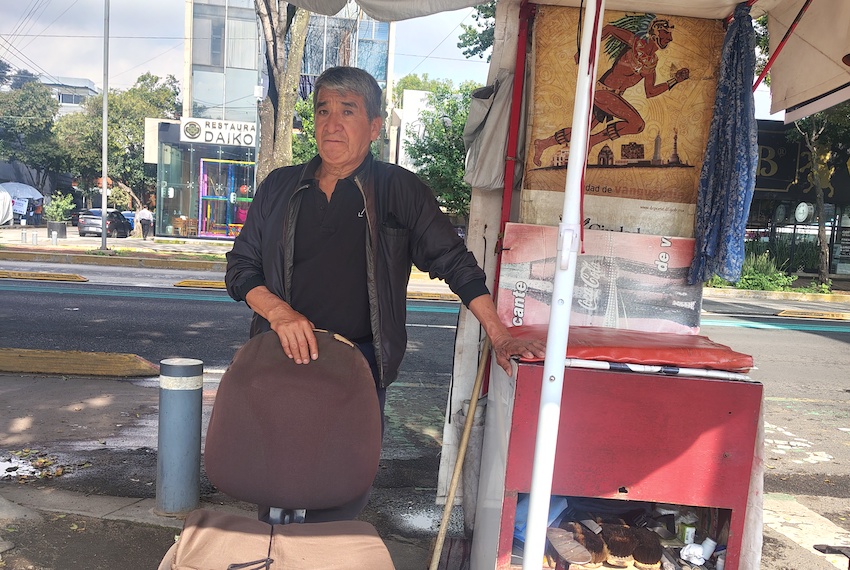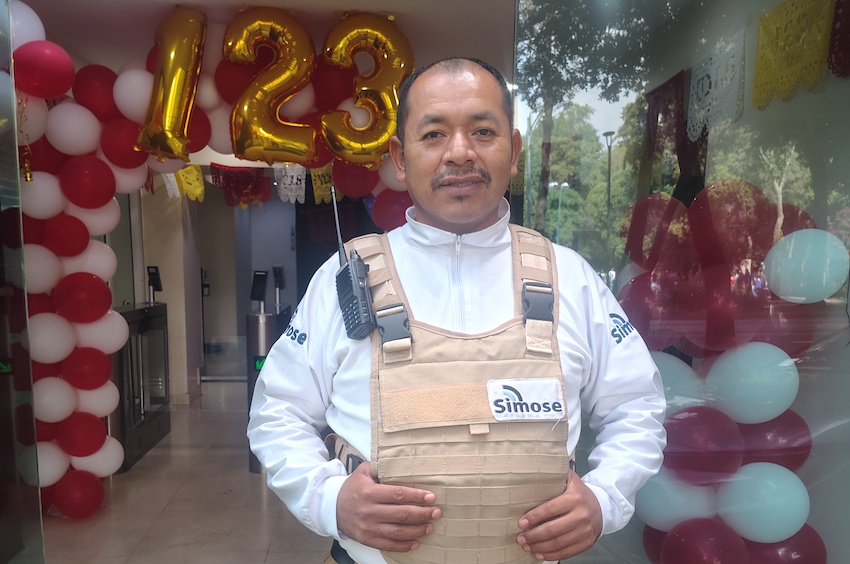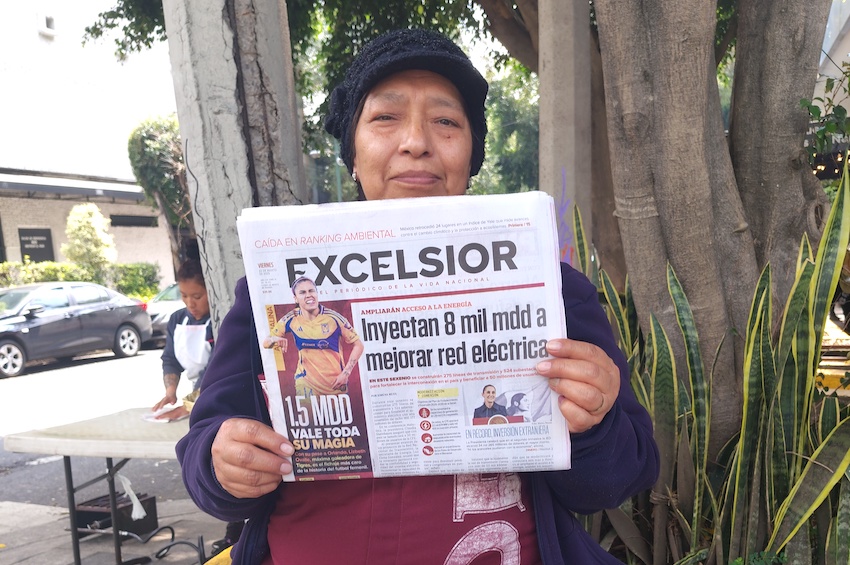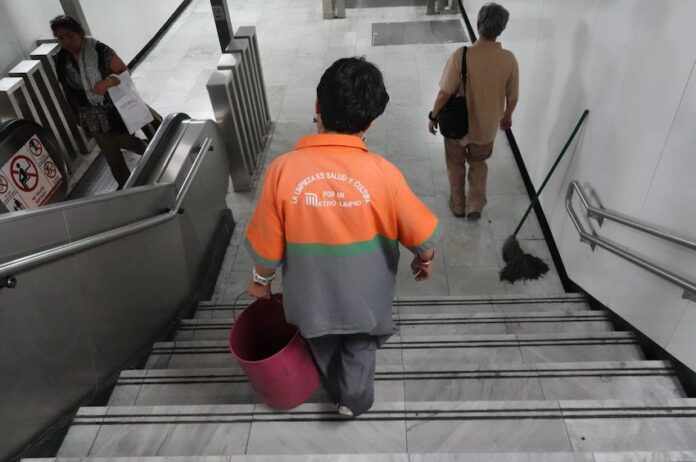It’s just after 9 a.m. on a Friday morning and a seasoned shoeshiner is standing next to his stand on Mexico City’s Insurgentes Avenue, waiting for a customer.
His small business, which he has run as a sole proprietor for 25 years, is doing well “gracias a Dios” (thank God), he tells Mexico News Daily, using an expression that is ubiquitous in conversations across the country.

Luis says that his earnings are variable, but he generally takes home between 500 and 1,000 pesos (US $27-54) per day.
If he were to work every day of the month, and consistently earn the higher daily amount he cited, Luis’s take-home pay (excluding his business expenses) would just exceed the 29,500-peso (US $1,580) amount that, on average, Mexico City residents say they need to cover their monthly expenses, according to the 2023 National Financial Health Survey.
For many other workers who labor in the vast informal economy in Mexico City — and in formal sector positions as well — their salaries don’t even come close to that amount, leaving them struggling to get by in a city that, in recent years, has become a significantly more expensive place to live.
An improving landscape for Mexican workers
There have been some positive changes for Mexican workers in recent years.
The minimum wage has increased. Annual paid vacation days have doubled from six to 12 for formal sector workers who have completed one year of employment. Workers now have the legislated right to sit down and take a break during their shifts.
According to President Claudia Sheinbaum, the increases to the minimum wage in recent years, as well as government support for millions of Mexicans in the form of welfare payments, were key factors that contributed to 13.4 million Mexicans exiting poverty between 2018 and 2024.
During former president Andrés Manuel López Obrador’s six-year term, the percentage of Mexicans classed as “the working poor” also declined, falling to its lowest level on record last year.
In light of this slew of good news stories, Mexico News Daily hit the streets of Mexico City to ask workers about their jobs, their salaries and their capacity to cover the cost of living in the capital. This article focuses on low-paid workers in the formal and informal sectors of the economy. Future articles will consider the situations of higher-paid workers.
The minimum wage is up, but making ends meet is still tough for low-paid workers
As the minimum wage increased in Mexico in recent years, so did consumer prices.
Mexico’s annual inflation rate hit 8.7% in August 2022 — the highest level in more than two decades — and remained high in 2023 and 2024 before beginning to stabilize this year and consequently approach the Bank of Mexico’s 3% target.
Rents — which eat up a substantial portion of many workers’ salaries — have risen in Mexico City and other parts of the country in recent years, forcing some residents of the capital to relocate to more affordable, less central areas.
Indeed, virtually any resident of Mexico City will attest that the cost of living has increased significantly in recent years. Across Mexico, the majority of people — almost 84 million — don’t earn enough to pay for all of their basic needs, including food, housing, education and transport, according to a recent study by the think tank México ¿cómo vamos?
Below you will find a series of snapshots of the situations of low-paid workers in Mexico City, who feel the cost-of-living pressures as acutely as anyone.
Most of the workers Mexico News Daily spoke to for this article earn less than the average daily base salary of a formal sector worker, which was 614.3 pesos (US $33) at the end of July. The daily minimum wage in most of the country is set at 278.80 pesos.
Based on their salaries, they are part of Mexico’s predominant lower class, according to the social class salary criteria established by the national statistics agency INEGI.
The amaranth salesman
On Félix Cuevas Avenue in the Del Valle neighborhood of Mexico City, an elderly vendor of alegría (bars of amaranth topped with nuts and raisins) told Mexico News Daily that he is paid 1,000 pesos (US $54) per week by his patrón (boss), who supplies him with his product.
He described the amount — which equates to a daily rate well below the minimum wage — as “very little.”
As a senior, the vendor — who has been selling alegría (literally happiness) for 15 years — is eligible for Mexico’s old-age pension of 6,200 pesos (US $332) every two months.
However, even when adding his meager wage and his pension together, the monthly total is below the minimum wage, which is 8,364 pesos (US $447) per month in most of the country, including Mexico City.
The security guard
Outside a Montepío Luz Saviñón pawn shop on Insurgentes Sur (the southern section of Insurgentes Avenue), a security guard told MND that he takes home 4,500 pesos per quinceña, a period of 15 days.

His salary — 9,000 pesos (US $482) per month — is slightly above the monthly minimum wage.
Jorge, who is employed by the private security company Simose, said that his salary has gone up thanks to the increases to the minimum wage in recent years, but is still “not enough,” especially considering he has a family to support.
Nevertheless, Jorge said he is grateful that he has a stable job with benefits, including medical insurance and an end-of-year bonus. He also said he is happy with what the current and former federal governments have done for workers.
Jorge also told MND that he likes his job, and — knock on wood — hasn’t had any major security problems to deal with.
The newspaper vendor
Further along Insurgentes, Mexico News Daily met 61-year-old Elpidía Juárez, who for the past seven years has been selling newspapers to passing pedestrians and motorists for Excélsior, the self-described “newspaper of national life.”
She said she earns 294 pesos (about US $16) a day, an amount slightly above the minimum wage and almost triple the 100 pesos per day she was paid when she first started with Excélsior in 2018.
Thanks to the annual increases to the minimum wage, Elpidía has seen firsthand the changes to her monthly income during her employment with the newspaper.
Juárez said she is paid weekly, taking home 1,470 pesos (US $79) for a five-day workweek. She said that her wage isn’t dependent on the number of newspapers she sells, and explained that she can return any unsold copies to Excélsior without incurring any penalty.

Juárez said she enjoys full benefits in her job, and noted that she has applied to receive the federal government’s “well-being” pension for women aged 60 to 64. Women aged 63 and 64 are already receiving a 3,000-peso (US $160) payment every two months and the scheme will be extended to younger sexagenarians soon.
Juárez, who agreed that the cost of living has increased significantly, said that the pension payment will help her and her husband cover their monthly expenses, including 6,000 pesos (US $320) rent for their apartment near Plaza Garibaldi, the square in the historic center of Mexico City where mariachi musicians entertain revelers around the clock.
The car washer
Luis, the second person of that name MND met on a recent Friday, washes and details cars at a Cadillac dealership on Insurgentes Sur. He said he has been in the job for six months and is paid around 4,000 pesos (US $214) per quincena, an amount more or less in line with the minimum wage.
Luis, who works eight hours a day six days a week, said he is happy with his current wage, although he admitted that it doesn’t go very far.
He expressed optimism that he could get a raise if he continues to work hard.
The pharmacy employee
Outside a Farmacias Similares drugstore on Insurgentes Sur, MND spoke to Ángeles, who in the absence of Dr. Simi himself was doing her best to promote the pharmacy and lure customers in to make a purchase.
She said that she works five days a week and takes home between 3,000 and 4,000 pesos (US $160-$214) per quincena depending on her hours. She also receives benefits.
Ángeles said that she has benefited from the increase in the minimum wage, but still finds it difficult to cover her expenses each month.
The Herbalife worker
Juan Hurtado is 40 years old and has worked for 10 years at a Herbalife store located near Insurgentes Sur.
He told MND that he takes home 10,000 pesos (US $535) per month, but noted that he only works five hours a day five days a week, which works out to just over half the standard 48-hour workweek in Mexico. He also receives benefits as part of his formal sector employment package.
Hurtado said that 10,000 pesos per month wouldn’t be enough to live on if he were to live alone. Consequently, he shares an apartment with his brother not too far from where he works.
Hurtado noted that a lot of workers in central Mexico City travel long distances to get to work. “They don’t have a life,” he said.

Hurtado also said that he is always thinking about and looking for ways he can increase his income. He currently sells dietary supplements and health food products as a side gig, sometimes even personally delivering the goods to his customers’ homes.
The Pemex attendant
Mexico News Daily visited a Pemex gas station on the corner of Insurgentes Sur and División del Norte Avenue, where a young man was working his fourth shift pumping gas.
He and two of his colleagues told Mexico News Daily that their income comes solely from the tips they receive from motorists.
“You do very well, I didn’t know that,” the young man said, explaining that he had earned between 500 and 800 (US $27-$43) pesos per day in his admittedly short career so far as a Pemex gas station attendant.
While such amounts are well above the minimum wage, an income that is solely dependent on tips is, because of its very nature, unreliable and inconsistent.
Nevertheless, the worker MND spoke to was happy with his lot, and happy to talk — until a superior told him it was time to get back to work.
NOTE:
* Salaries, of course, are variable, and two people doing the same job aren’t necessarily paid the same salary.
** Workers who earn the minimum wage in Mexico are exempt from paying income tax.
*** Salaries (and expenses) are higher in Mexico City than in many other parts of the country, but the minimum wage in the capital is the same as that in most of the country. A higher minimum wage applies in Mexico’s northern border region.
What about OXXO workers and Uber drivers?
Ever wondered how much the person who sells you beer in OXXO earns? Or how much your Uber driver takes home?
Mexico News Daily has compiled salary data for 10 different jobs from the employment website Indeed. The amounts listed are average monthly salaries, and apply to Mexico City rather than the country as a whole in some cases.
The earnings of workers in many positions can vary considerably due to a range of factors, including their location in Mexico and the number of hours they work. The salaries listed below are intended to be a guide rather than a precise tabulation.
- A supermarket cashier earns around 4,900 pesos per month (US $262).
- An OXXO store assistant earns around 7,700 pesos (US $412). (As this OXXO worker explains, employees’ earnings can increase thanks to bonuses and other incentives.)
- A cleaner earns around 7,850 pesos (US $420)
- A gardener earns 8,040 pesos (US $430) in Mexico City.
- A waiter earns around 8,500 pesos (US $455), excluding tips.
- An Uber driver earns around 9,800 pesos (US $524). (Digital platform workers are now eligible for formal sector employment benefits thanks to recently approved labor law reforms.)
- A domestic worker earns about 9,850 pesos (US $527) in Mexico City. (Such workers are supposed to be registered in social security by their employers, but many are not.)
- A hotel receptionist earns about 10,350 pesos (US $553).
- A taquero (taco cook and/or vendor) earns about 10,700 pesos (US $572) in Mexico City.
- An albañil (construction worker/bricklayer) earns about 10,900 pesos (US $583).
By Mexico News Daily chief staff writer Peter Davies (peter.davies@mexiconewsdaily.com)
